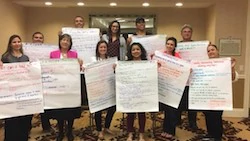Big Decisions
Published 2018

"For the first time, I experienced the students really learning, right in front of me."
- Big Decisions teacher
Program Description
Big Decisions is an “abstinence-plus” curriculum that encourages young adolescents to postpone sexual involvement, while also providing guidance and information to reduce the risks linked to sexual activity, such as pregnancy and sexually transmitted infections. The program, which engages youth and parents, is designed to be accessible to all communities. Originally developed for urban youth, Big Decisions is undergoing a rigorous evaluation to determine its effectiveness for youth in rural settings near the US-Mexico border and contribute knowledge to the teen pregnancy prevention evidence base.
- Population: 9th-grade students, predominantly (>90%) Hispanic
- Locations: Three rural counties near the southwest Texas border
- Partners: Local school districts, Philliber Research & Evaluation, Cardea Services
Goals
- Help young people make healthy, informed decisions about sex.
- Promote abstinence, as well as condom and other contraceptive use if teens have sex.
- Promote communication between parents and their teens about sexual decision-making and health.
"It’s been really great. Big Decisions lets us have really meaningful classroom conversations. We get to know the students better. They really participate."
- Big Decisions teacher
Strategies
Classroom lessons
Big Decisions consists of 10 interactive lessons on goals, relationships, and sexual health offered to 9th-grade students. Classroom teachers, who receive three days of training from Healthy Futures of Texas and Cardea Services, deliver the lessons to students during normally scheduled classes. Lessons incorporate three key messages: (1) having sex is a big decision; (2) abstinence is the most effective way to avoid both pregnancy and sexually transmitted infections; and (3) those who have sex need to use latex condoms correctly every time to reduce the risk of HIV and other sexually transmitted infections and use contraception to prevent pregnancy.
Parent engagement
Parent engagement is encouraged through two components of the program: (1) “Homework” for students to discuss sexual health-related topics with a parent or other trusted adult; and (2) Key Conversations, a 2-session program for parents to learn what helps teens avoid pregnancy, including abstinence. Through role-plays and other interactive exercises, Key Conversations teaches parents about sexual health and allows them to practice talking with their teens about sexual health and decision making. The program is offered in both English and Spanish.
In 2016-17, Big Decisions students, compared to students in a control group, were more likely to report that they talk to their parents about:
- Abstinence and how a pregnancy might affect their goals
- Sex (males only)
Stats at a Glance
- 63.5-80.3 range of 2015* teen birth rates (per 1,000 females ages 15-19) in the three counties where Big Decisions is implemented1,2
- 22.3 national teen birth rate (per 1,000 females ages 15-19) in 20153
- 2,300 students participated in Big Decisions (2015-2018)
- 94% Big Decisions students liked the program (2015-2018)
- 95% Big Decisions students felt their teacher supported and accepted them (2015-2018)
*Reflects the most recent year for which data are available.
Grantee Information
Rene A. Gonzalez
Program Director
210-223-4589
RGonzalez@hf-tx.org
www.hf-tx.org/programs/bigdecisions/
Print the full success story here.
About the TPP Program
The Office of Adolescent Health Teen Pregnancy Prevention (TPP) Program is a federal grant program that funds diverse organizations working to prevent teen pregnancy across the United States. OAH invests in both the implementation of evidence-based programs and the development and evaluation of new and innovative approaches to prevent teen pregnancy. The OAH TPP Program reaches adolescents age 10-19, with a focus on populations with the greatest need in order to reduce disparities in teen pregnancy and birth rates.
Footnotes
1 Calculations were done by OAH for this publication using the following source: Texas Department of State Health Services, Center for Health Statistics, Texas Health Data. (2018). Live Births (2005+), Texas Births by Age of Mother. Retrieved August 10, 2018 from http://healthdata.dshs.texas.gov/VitalStatistics/Birth
2 Calculations were done by OAH for this publication using the following source: Texas Department of State Health Services, Center for Health Statistics, Texas Health Data. (2018). Population Estimates (1990-2015). Retrieved August 10, 2018 from http://healthdata.dshs.texas.gov/Population
3 Martin, J.A., Hamilton, B.E., Osterman, M.J., Driscoll, A.K., & Mathews, T.J. (2017). Births: Final data for 2015. National Vital Statistics Report, 66(1). Hyattsville, MD: National Center for Health Statistics. Retrieved July 31, 2018, from https://www.cdc.gov/nchs/data/nvsr/nvsr66/nvsr66_01.pdf - PDF
